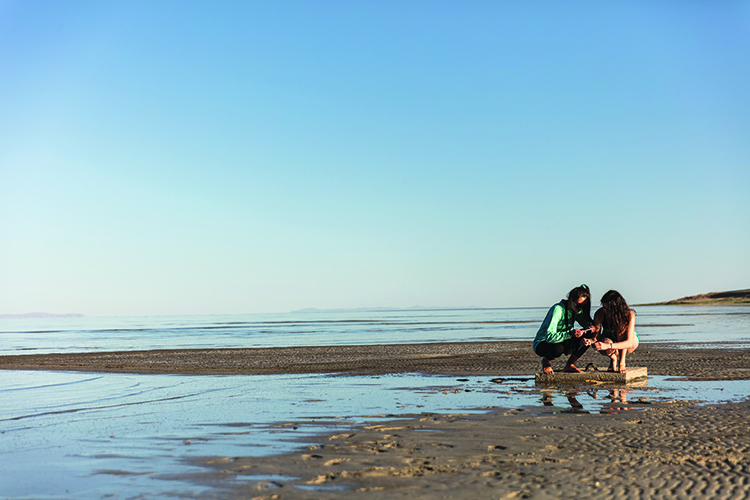
The Sticky Truth

Westminster student’s donor-funded research at Great Salt Lake leads to new discoveries surrounding life and climate change
by Meg Quigley
When Cayla Martin (’22) came to Westminster and got involved with the Great Salt Lake Institute (GSLI), the South African native was stunned to find that some people in Utah have a negative view of the lake. “The water is pink!” she exclaims. “There are these salt crystals on the ground that crunch as you walk on them. When I first visited, I thought it was the most incredible place on earth.”
With a passion for nature and biology, Cayla quickly found a home at GSLI. Her first student-research project with GSLI involved monitoring tar seeps on the north side of the lake. The tar seeps are close to Gunnison Island, a major breeding ground for American white pelicans. Because of how salty the lake is, the pelicans must fly every day to wetlands to get the resources they need. As young pelicans fly over the tar seeps, they often get stuck, which results in tar seeps cluttered with the decomposing bodies of pelicans and other animals.
The GSLI team monitors the pelicans and other animals through motion-activated cameras on the tar seeps to study how and why animals become entrapped. While downloading camera content, Cayla and her research partner heard a crackling sound. “It turned out there might be actual organisms living in the tar—and they are burping out these gases,” Cayla explains.
This discovery led to sampling the tar to explore what is living in it. Cayla works with biology professor David Parrott to study samples both close to the decaying pelicans and from farther away. “The organisms that I’m studying could have application in degrading oil in oil spills,” Cayla says.
There are also potential implications for climate change. The naturally occurring tar seeps could be emitting a lot of greenhouse gases that are not currently included in the global greenhouse gas budget. If these natural emissions are underestimated, it means that the gases causing climate change are greater than we understand—and the need to act is even more urgent. “We need to control man-made emissions,” Cayla explains, “because we can’t stop the natural emissions.”
GSLI does not currently have the expensive equipment needed to sample the gas being emitted from tar seeps. She is hopeful that one day they can secure funds to conduct this research and contribute to the global data on greenhouse gases and climate change.
In the meantime, she is thrilled with the research opportunities she has received. Thanks to long-term donors, including the Lawrence T. and Janet T. Dee Foundation, the Denkers family, Preston Chiaro, and many more, GSLI has supported 63 student researchers over three years working with 20 faculty across disciplines including biology, performing arts, chemistry, music, English, education, math, public health, and environmental studies.
Coming to the United States and to Westminster, Cayla was blown away by the immense support from donors. “It’s not something I’ve ever experienced before. Without that generosity, I don’t know where Westminster and the Great Salt Lake Institute would be.”
About the Westminster Review
The Westminster Review is Westminster University’s bi-annual alumni magazine that is distributed to alumni and community members. Each issue aims to keep alumni updated on campus current events and highlights the accomplishments of current students, professors, and Westminster alum.
GET THE REVIEW IN PRINT Share Your Story Idea READ MORE WESTMINSTER STORIES